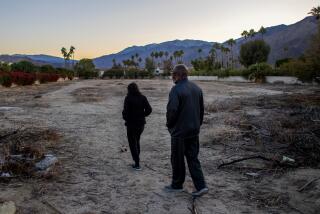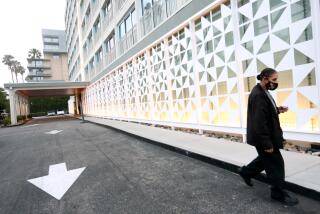For Sun Village and Littlerock, historic distrust persists
When Virginia Jo Miller first saw the high desert community of Sun Village in 1962, her heart sank. There were no streetlights, no paved roads. Many homes had no electricity. The setting was desolate, “nothing but tumbleweed, jackrabbits and snakes,” recalled Miller.
The rest of Southern California was booming, with working families similar to hers settling into comfortable subdivisions. But Miller, 68, and her husband, Jerry, were denied that life: They were African American at a time when discriminatory real estate practices throughout Southern California confined black home buyers to certain, often undesirable areas. In the Antelope Valley, that meant Sun Village — hot, isolated and miles from any job center.
Jerry’s commute to his job driving a catering truck at Edwards Air Force Base was more than 30 miles away. The couple used a generator for indoor lighting. Houses were scattered through the settlement. Some nights, the streets were so dark that residents coming home late stayed with friends on the outskirts of town because they couldn’t find their houses.
But the Millers didn’t give up, nor did their neighbors. Residents in the all-black area fought for services, started churches and businesses, spruced up homes. They turned Sun Village into a desirable address, and Miller grew to love the place.
Then came a new affront: People forgot.
The years erased many of the old racial wrongs. Barriers to integrated housing fell. African Americans spread out; Latinos edged out blacks and became the majority. Sun Village had been separated from Littlerock — the predominantly white farm town next door — by an invisible racial line. But by the 1990s, the two appeared so thoroughly blended that many disagreed over where one ended and the other began.
Yet the new order rankled some Sun Villagers.
Small stuff at first: Though Sun Village’s population is nearly 12,000, it was the name of Littlerock — population about 1,400 — that appeared on freeway signs. The Sun Village post office was closed; one in Littlerock stayed open. The school district opened a high school in Sun Village — and local trustees named it Littlerock High.
Then when Littlerock leaders decided to hold their meetings in Sun Village, years of pent-up anger flared.
“We built our community with blood, sweat and tears, persevered,” said Eugene Washington, 59, president of the Town Council. He and a small group of neighbors are resisting what they see as encroachment by Littlerock.
It’s an effort met with puzzlement and pique by Littlerock leaders, who insist that they are not trying to take over. But several also implied that the Sun Village activists are holding a grudge — that they can’t move past their grievances. Tensions have grown. Charges of racism have flown both ways.
The issues are almost purely symbolic. But the tone of the debate suggests broader differences:
“There is a perception by a couple of Sun Village council people that they have been wronged to the point that nothing we do ... is going to cut any ice with them,” said longtime Littlerock resident and council member Carl Iannalfo. He added that some Sun Village leaders still talk about being owed “40 acres and a mule” as a reason not to trust Littlerock.
“We’re not out to eradicate them or modify their way of living in any way,” he said.
But Washington remembers when Littlerock didn’t want anything to do with Sun Village — when a black person “wouldn’t dare say you lived in Littlerock,” for fear of angering whites. “It’s all right for Sun Village to be Littlerock now?” he fumed.
Littlerock and Sun Village are both unincorporated areas of Los Angeles County. There is disagreement over boundaries, but many Sun Village residents hold that their community is bounded by Avenue Q on the north, 135th Street on the east, Avenue T on the south and 80th Street on the west. It has its own chamber of commerce and town council (whose powers, like the Littlerock town council’s, are strictly advisory).
Yet many nearby residents, and even some local officials, have never heard of it or presume it is a neighborhood in Littlerock.
As old-timers tell it, the settlement began in the 1940s when Melvin Ray Grubbs, a black lawyer turned real estate agent from Chicago, brokered the purchase of a thousand acres from a white family named Marble, which owned Sun Village Land Corp. and was willing to sell to blacks.
From the start, conditions were harsh. Cecil J. Harris, 79, recalled that his mother, a domestic worker, bought an acre in 1945 and built a home out of used lumber. There was no gas. People kept propane tanks in their yard, Harris said.
Racial prejudice was rife in neighboring communities, such as Littlerock and Palmdale, where a black person could wait three hours to get served in a restaurant or store, Harris said.
But the settlers also found aspects to like: plots of an acre or more, equestrian rights and the chance to be part of a larger project. Many blacks came from South Los Angeles, others from out of state. “They had a vision” to create an “oasis in the desert,” said James Brooks, 64, president of the Sun Village Parks Assn., an organization started in 1958. “Because of the environment” of discrimination, “it caused the people of Sun Village to be self-sufficient and independent. It made people pull closer together.”
The Sun Village Women’s Club donated land for the much-prized Jackie Robinson Park, which the baseball legend helped dedicate in 1965. A shopping area boasted a butcher, nightclubs and restaurants, among them Mabel’s, known for its “American fare with a touch of soul.”
Today, the park office displays a collection of old photos and newspaper clippings that document life in Sun Village, such as the annual Juneteenth celebration. The shovel that dug the first piece of earth for the park hangs over a door.
“You knew everyone’s family. There was a sense of community,” said Lola Berryman, 59, who today cares for her mother in the bungalow-style home the family moved into in 1968.
Like the clash over the high school name, what’s mainly at issue in the periodic disputes between Sun Village and Littlerock is pride, identity and memory, since there is little material or political advantage at stake. County supervisors are the chief decision-makers for the latter.
Tony Bell, a spokesman for Supervisor Michael D. Antonovich, said the county recognizes both town councils and helped Sun Village get four signs posted on its streets. (State officials couldn’t explain exactly why the freeway signs have said only “Littlerock” for years now. Recently approved “Sun Village” signs have not yet been installed.)
Bell said the county “provides services without regard to where a community begins and ends.”
At one point, Littlerock leaders organized public meetings so residents could comment on community standards for the southeastern Antelope Valley. Sun Village leaders were invited but refused to come, said Tom Fidger, vice president of the Littlerock Town Council. Eventually, both communities agreed on the need to protect the area’s rural character. But Brooks acknowledged that “we had some real knock-down battles.”
The flap died down until July — some time after the Littlerock Town Council switched its meeting spot to the high school in Sun Village.
Sun Villagers view the high school as a center of their community and saw the move as a sign that Littlerock residents considered it their turf.
Iannalfo said his group has every right to meet in the school because it’s a public venue. Littlerock had gone out of its way to work with Sun Village leaders, he said, but the overtures have been met with resistance.
“Now we’ve got a faction of people on our council that think ‘to heck with them,’ ” Iannalfo said.
Fidger said the audacity of Sun Village leaders’ demands for Littlerock council members to “get out of town” was the final straw for him. He accused activists of “living in the ‘50s.”
Washington, Sun Village’s president, insists that such talk smacks of the “R” word. “Let’s call it what it is,” he said. “Just a new form of racism.”
Littlerock leaders have hurled back the charge: “They’re the ones being racist,” Fidger said.
To Brooks, Sun Village and its past are symbolic of the trials African Americans faced nationwide during America’s ugly history of racial segregation. He doesn’t want it forgotten — nor the fact that the community prevailed.
“The history of Sun Village is the history of the Antelope Valley and the history of America,” Brooks said. It “should be sung throughout the valley.”
More to Read
Start your day right
Sign up for Essential California for news, features and recommendations from the L.A. Times and beyond in your inbox six days a week.
You may occasionally receive promotional content from the Los Angeles Times.







